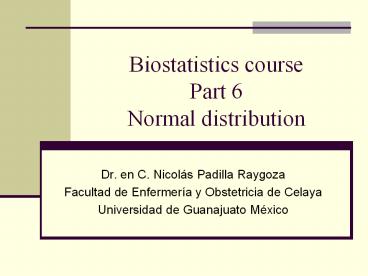Biostatistics course Part 6 Normal distribution - PowerPoint PPT Presentation
Title:
Biostatistics course Part 6 Normal distribution
Description:
M dico Cirujano por la Universidad Aut noma de Guadalajara. ... Practical statistics for medical research. Boca Rat n, Chapman & Hall/ CRC; 1991: 1-9. ... – PowerPoint PPT presentation
Number of Views:81
Avg rating:3.0/5.0
Title: Biostatistics course Part 6 Normal distribution
1
Biostatistics coursePart 6Normal distribution
- Dr. en C. Nicolás Padilla Raygoza
- Facultad de Enfermería y Obstetricia de Celaya
- Universidad de Guanajuato México
2
Presentación
- Médico Cirujano por la Universidad Autónoma de
Guadalajara. - Pediatra por el Consejo Mexicano de Certificación
en Pediatría. - Diplomado en Epidemiología, Escuela de Higiene y
Medicina Tropical de Londres, Universidad de
Londres. - Master en Ciencias con enfoque en Epidemiología,
Atlantic International University. - Doctorado en Ciencias con enfoque en
Epidemiología, Atlantic International University. - Profesor Asociado B, Facultad de Enfermería y
Obstetricia de Celaya, Universidad de Guanajuato.
- padillawarm_at_gmail.com
3
Competencies
- The reader will define what is Normal
distribution and standard Normal distribution. - He (she) will know how are the Normal and
standard Normal distribution. - He (she) will apply the properties of standard
Normal distribution. - He (she) will know how standardize values to
change in a standard Normal distribution.
4
Introduction
- We know how calculate probabilities and to find
binomial distribution. - But, there are other variables that they can take
more values that only two. - If they have a limited number of categories, are
categorical variables. - If they can take many different values, are
numeric variables.
5
Quantitative variables
- They can take many values and are negative or
positive.
6
Quantitative variables
7
Quantitative variables
- What happen if the sample size is more big?
- Changed the histogram?
8
Quantitative variables
- The distributions of many variables are
symmetrical, specially when the sample size is
big.
9
Normal distribution
- It is used to represent the distribution of
values that they should observe, if we include
all population. It show the value distribution,
if we repeat many times the measure in a great
population. - Because of this, Y axis of Normal distribution is
called probability. - An histogram show the value distribution observed
in a sample. - An Normal plot show value distribution that it is
thinking that they can occur in the population of
which the sample was obtained.
10
Normal distribution
- We can use the Normal distribution, to answer
questions as - What is the probability of a adult man has a
glycemia level lt or to 50 mg/100 ml? - We can answer, taken the percentage of observed
men, with glycemia levels lt 150 mg/100 ml.
11
Normal standard distribution
- Normal distribution is defined by a complicated
mathematical formulae, but we have published
tables that define area under the Normal curve
Normal standard distribution. - In this the mean is 0 and standard deviation is
1. - These tables are in statistic textbooks.
12
Normal standard distribution
- When Z0.00 is 0.5
- When Z 1.00 is 0.159 or 0.841
13
Normal standard distribution
- Many times, we want the range out of area of
curve. - Area out of range is complementary to the range
in of area of the curve.
Range Area in the range Area out the range
-1, 1 68.3 31.7
-2, 2 95.4 0.6
-3, 3 99.7 0.3
-4, 4 99.99 0.01
14
Normal standard distribution
- Area out of range is that we shall use with more
frequency. - There are tables published with these values and
they are the table with two tails.
15
Standardized values
- Any Normal distribution can be changed in a
Normal standard distribution. - To standardize value, we subtract of each value
its mean and it is divided by standard deviation. - Example
- Mean of stature is 1.58 mt with s 0.12
- Standardized value for stature of 1.7 is 1.7 -
1.58/0.12 0.12/0.12 1.00
16
Standardized values
- How we do apply the lessons learned?
- What is the probability of one person in the
population, has less than 1.6 mts of stature? - We know that should calculate what is the area
under curve to the left of 1.6 mts, under a
Normal curve with a mean of 1.58 and s of 0.12. - 1.6 -1.58/0.12 0.167
- Using the tables of Normal standard distribution
p lower value (to the left of mean) for 0.167 is
0.5675 56.75. - We can answer that the probability of an
individual of this population has less than 1.6
mts is 56.75 - It is a population with low stature!
17
Standardized values
- Cautions
- Sample size
- We have used a sample of 1000 measures, if the
sample size is less, the results are different. - Supposition
- The results depend of the supposition that
statures are distributed Normally with the same
mean and standard deviation found in the sample. - If the supposition is incorrect, the results are
wrong.
18
Non-Normal distribution
- Not all quantitative variables have a Normal
distribution. - We measured levels of glycemia in 10 personas
the distribution are skewed. - Do we can use the properties of Normal
distribution?
19
Non-Normal distribution
- If, it is skewed to the right, we can apply
logarithmic transformations. - If, it is skewed to the left, we squared each
value. - Original values is transformed in natural
logarithmic values (button ln in scientific
calculators).
20
Bibliography
- 1.- Last JM. A dictionary of epidemiology. New
York, 4ª ed. Oxford University Press, 2001173. - 2.- Kirkwood BR. Essentials of medical
ststistics. Oxford, Blackwell Science, 1988 1-4. - 3.- Altman DG. Practical statistics for medical
research. Boca Ratón, Chapman Hall/ CRC 1991
1-9.

